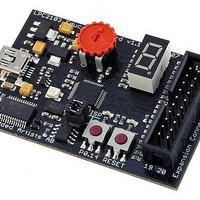EA-EDU-009 Embedded Artists, EA-EDU-009 Datasheet - Page 18

EA-EDU-009
Manufacturer Part Number
EA-EDU-009
Description
MCU, MPU & DSP Development Tools LPC2103 EDUCATION BRD
Manufacturer
Embedded Artists
Specifications of EA-EDU-009
Processor To Be Evaluated
LPC2103
Data Bus Width
16 bit, 32 bit
Interface Type
I2C, SPI, UART
Core
ARM7TDMI-S
Dimensions
68 mm x 42 mm
Maximum Operating Temperature
+ 85 C
Operating Supply Voltage
3.3 V
Lead Free Status / RoHS Status
Lead free / RoHS Compliant
NXP Semiconductors
LPC2101_02_03_4
Product data sheet
6.17.3 Reset and wake-up timer
Reset has two sources on the LPC2101/02/03: the RST pin and watchdog reset. The RST
pin is a Schmitt trigger input pin with an additional glitch filter. Assertion of chip reset by
any source starts the wake-up timer (see wake-up timer description below), causing the
internal chip reset to remain asserted until the external reset is de-asserted, the oscillator
is running, a fixed number of clocks have passed, and the on-chip flash controller has
completed its initialization.
When the internal reset is removed, the processor begins executing at address 0, which is
the reset vector. At that point, all of the processor and peripheral registers have been
initialized to predetermined reset values.
The wake-up timer ensures that the oscillator and other analog functions required for chip
operation are fully functional before the processor is allowed to execute instructions. This
is important at power on, all types of reset, and whenever any of the aforementioned
functions are turned off for any reason. Since the oscillator and other functions are turned
off during Power-down and Deep power-down mode, any wake-up of the processor from
the Power-down modes makes use of the wake-up timer.
The wake-up timer monitors the crystal oscillator as the means of checking whether it is
safe to begin code execution. When power is applied to the chip, or some event caused
the chip to exit Power-down mode, some time is required for the oscillator to produce a
signal of sufficient amplitude to drive the clock logic. The amount of time depends on
many factors, including the rate of V
and its electrical characteristics (if a quartz crystal is used), as well as any other external
circuitry (e.g., capacitors), and the characteristics of the oscillator itself under the existing
ambient conditions.
Rev. 04 — 2 June 2009
DD
ramp (in the case of power on), the type of crystal
Single-chip 16-bit/32-bit microcontrollers
LPC2101/02/03
© NXP B.V. 2009. All rights reserved.
18 of 37



















